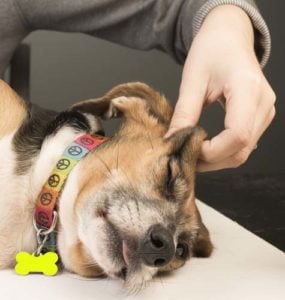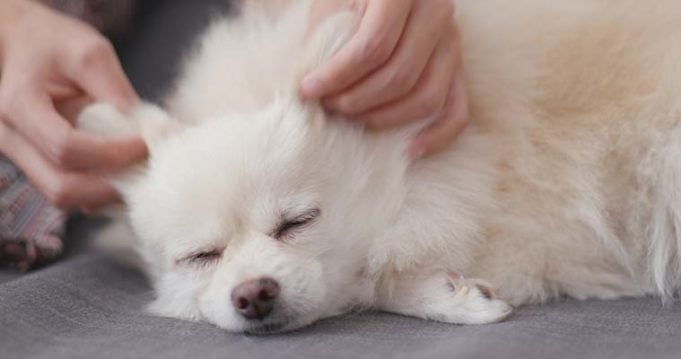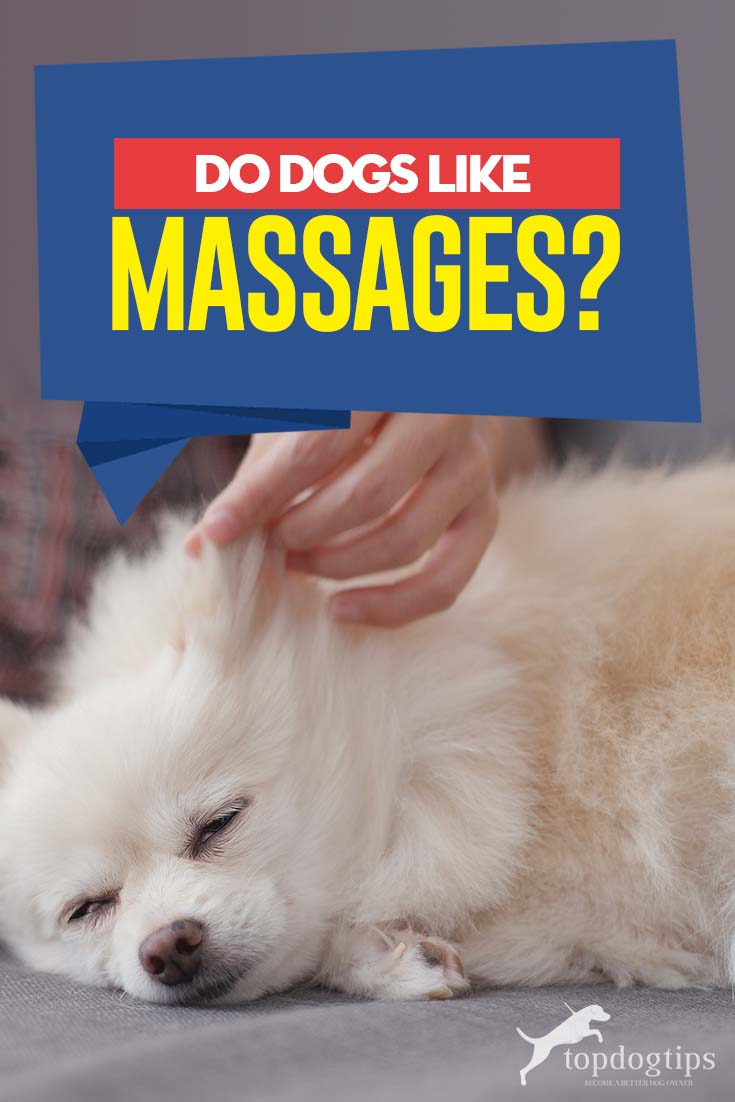If there is no denying that your dog enjoys it when you pet them, then they're very likely love a good doggy massage. So do dogs like massages? The answer is YES – most dogs love being massaged in a gentle way. And not only does a dog massage feel comforting, relaxing and pleasurable for your pooch, but there are many actual health benefits that massaging your dog on a regular basis can bring.
The reason why most dogs like massages is exactly the same why most people enjoy a good, relaxing massage. On top of that, massaging your dog has therapeutic benefits between you and your pooch, and this process also triggers release of “love” hormone called oxytocin in pet owners while they massage their dogs. Other studies have shown that massaging your dog can also lower your heart rate and your blood pressure, but today, we'll discuss the benefits of massage for your pooch.
Most owners haven't yet concerned themselves to dedicated 5-10 minutes a few times a week to massage a dog, but once you know more about what dog massage therapy is and its many proven benefits, you may be inclined to try to give your pet a massage or even hire a dog masseuse. But there are also important things that you should know before sending your dog off to get a massage or trying to give them one yourself.
ALSO READ: Benefits of Hydrotherapy and Underwater Treadmills for Dogs
Dog Massage Therapy Benefits
Massage therapy for dogs is a type of alternative therapy to specifically relax your dog while also promoting physical and mental health. This type of therapy can assist dogs who suffer from a variety of ailments. Massage therapy might be suggested for your pup if they are hyperactive, have excessive anxiety, are overly nervous, have sore muscles, arthritis, gas problems, and many other issues, big or small.
Most well-known benefits of dog massage include, but are not limited to the following:
- Stress or behavior reduction
- Pain relief
- Increase blood circulation and oxygenation
- Increase flexibility
- Liver and kidney stimulation
- Improved immune system
- Better digestion
- Decreased blood pressure
- Decreased discomfort related to hip dysplasia or arthritis
Massaging is one of the things animal physical therapists do to help to rehabilitate, reduce pain and swelling in the dogs. This process also helps in healing injuries faster, including a variety of muscle spasms, sprains and strains. Some therapists even claim that it can keep scar tissue to a minimum while also improving dog's bodily functions.
Furthermore, just like grooming your pooch, dog massage will not only act as a healing therapy but it will increase and strengthen the bond and relationship that you have with your canine companion when you choose to give the massage yourself. And that is an important difference – going DIY style, or hiring a dog masseuse, so let's talk about the differences and benefits of each option.
Dog Masseuse / Dog Massage Therapist
Your veterinarian may suggest Canine Massage Therapy to help with a certain ailment that is bothering your pet. Sometimes, it is recommended for dogs to go to a specially trained dog massage therapist. Most people typically choose their dog’s canine massage therapist in a similar way to how they chose their veterinarian. In addition to asking your dog’s current veterinarian for suggestions, it is important to choose the best fit for you and your pup. Once you have your veterinarian’s suggestions, you should complete the following steps:
- Ask friends, family, or neighbors for suggestions if they have used this type of therapy for their dog.
- Check online for reviews. Read the comments of former and current patients.
- Locate their office. You will want to choose a dog massage therapist who is not too far from your home and the location is easy to get to.
- Verify that their hours of business are convenient for you.
- Find out the rates and any related fees.
- Make a list of your top choices and call the offices. Make sure that the staff clearly answers any questions you may have and is friendly.
Weiters at Canine Bodyworks, experts in this area, note that a license is not required for a dog massage therapist to practice canine massage therapy; however, there is a national certification through the National Board of Certification For Animal Acupressure and Massage (NBCAAM).
To become a certified NBCAAM dog masseuse, a therapist must complete at least 200 hours of education and pass a certification exam. For more information on the certification exam requirements see NBCAAM's website. Additionally, some U.S. states require canine massage therapists to work under the direct or general supervision of a licensed veterinarian.
If, however, you'd prefer to take massaging your dog into your own hands, that's also a very viable option with its own unique benefits for the both of you (as long as you do this right). Here's what you should know.
How to Give a Dog Massage Yourself
 While there are some similarities between dog and human massages, pet massages for dogs are much different from those that people give or receive. The biggest difference between a dog massage and a human massage is the amount of pressure used. Humans are able to handle much more pressure than what a dog needs. In general, dog massages are much more gentle than a human massage.
While there are some similarities between dog and human massages, pet massages for dogs are much different from those that people give or receive. The biggest difference between a dog massage and a human massage is the amount of pressure used. Humans are able to handle much more pressure than what a dog needs. In general, dog massages are much more gentle than a human massage.
Samantha has previously published an article and step-by-step video on giving your dog massage, which you can read and watch here. We've also had pet massage experts on our Theory of Pets podcast to talk us through the process, safety and dangers, and I recommend you listen to this episode in particular.
In general, if you want to do it safely and effectively, there are eight steps that will guide you in giving your dog a massage. These steps include:
- Making sure your dog is calm prior to the start of the massage. A long walk prior to the massage may be beneficial.
- Talk softly to keep your dog relaxed and start by petting your dog softly all over.
- Use gentle, circular motions to massage your dog’s neck.
- After you have massaged your dog’s neck, massage down to their shoulders.
- Once the neck and shoulders have been massaged, move to the chest and front legs. Some dogs do not like their legs to be massaged and if this is your dog then feel free to move to the next step. Once you reach your dog’s feet be careful with the pads of the feet. They are very sensitive and your dog may have an involuntary reflex and kick.
- Continue to the back. Again, use gentle and circular motions to go up and down the spine.
- Finish with your dog’s tail area and back legs.
- Your dog should be relaxed and calm. In future sessions you may pick up on different reactions from your dog, which can tell you about problems they may be experiencing.
Other resources with tips on how to properly ensure that you are massaging your dog correctly include a bunch of other YouTube videos. Simply search for “dog massage” on YouTube, and browse through all the available tips, of which there are many.
 One thing pet owners who are just getting into dog massage therapy at home do not consider are all the available tools to make this process easier for you, and more pleasurable and/or effective for your dog and their health. For example, there's a collection of Petwell Massage Tools which are simple, affordable yet very effective; our editor Samantha has reviewed and demonstrated these tools in this video/article.
One thing pet owners who are just getting into dog massage therapy at home do not consider are all the available tools to make this process easier for you, and more pleasurable and/or effective for your dog and their health. For example, there's a collection of Petwell Massage Tools which are simple, affordable yet very effective; our editor Samantha has reviewed and demonstrated these tools in this video/article.
Other possible dog massage tools you can use are:
| Preview | Product | Rating | |
|---|---|---|---|

|
Cat Massager, Scalp Massager, USB Charging 3D Head... | 35 Reviews | Check Price |

|
PetWell Dual Point Handheld Massage Roller Pets... | 38 Reviews | Check Price |

|
Dog Grooming Brush - Dog Bath Brush - Cat Grooming... | 6,757 Reviews | Check Price |

|
Tilcare Handheld Pet Massager for Dogs and Cats... | 777 Reviews | Check Price |

|
PetWell Dual Point Handheld Massage Roller Pets... | 38 Reviews | Check Price |
So do dogs like massages? Most would say, overwhelmingly, YES – they do. Ultimately, dog massage therapy may be a good choice for you and your dog if you are concerned about their overall behavior or want them to recover faster from the numerous physical or mental health issues, on top of other benefits a dog massage provides.
Your veterinarian is a good point of reference to discuss this topic and they may also suggest specific dog massage tools, techniques or a masseuse. Whether you do this yourself or hire a certified professional, either way know that the health and behavior support that you are giving your dog through massage will definitely better their life.
READ NEXT: Muscle Atrophy in Dogs – Causes, Prevention and Treatments
Disclosure: We may earn affiliate commissions at no cost to you from the links on this page. This did not affect our assessment of products. Read more here and find full disclosure here.















